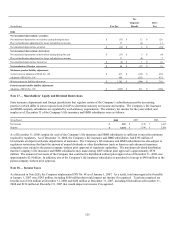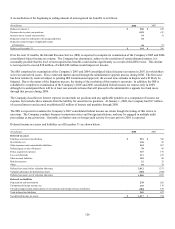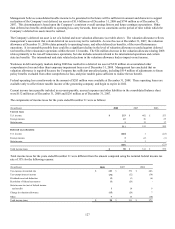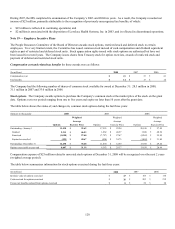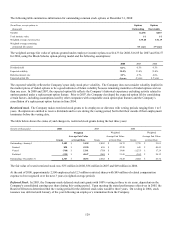Cigna 2008 Annual Report Download - page 155
Download and view the complete annual report
Please find page 155 of the 2008 Cigna annual report below. You can navigate through the pages in the report by either clicking on the pages listed below, or by using the keyword search tool below to find specific information within the annual report.
135
Other possible regulatory and legislative changes or judicial decisions that could have an adverse effect on the Company’s employee
benefits businesses include:
• additional mandated benefits or services that increase costs;
• legislation that would grant plan participants broader rights to sue their health plans;
• changes in public policy and in the political environment, which could affect state and federal law, including legislative and
regulatory proposals related to health care issues, which could increase cost and affect the market for the Company’s health
care products and services; and pension legislation, which could increase pension cost;
• changes in Employee Retirement Income Security Act (ERISA) regulations resulting in increased administrative burdens and
costs;
• additional restrictions on the use of prescription drug formularies and rulings from pending purported class action litigation,
which could result in adjustments to or the elimination of the average wholesale price or “AWP” of pharmaceutical products
as a benchmark in establishing certain rates, charges, discounts, guarantees and fees for various prescription drugs;
• additional privacy legislation and regulations that interfere with the proper use of medical information for research,
coordination of medical care and disease and disability management;
• additional variations among state laws mandating the time periods and administrative processes for payment of health care
provider claims;
• legislation that would exempt independent physicians from antitrust laws; and
• changes in federal tax laws, such as amendments that could affect the taxation of employer provided benefits.
The employee benefits industry remains under scrutiny by various state and federal government agencies and could be subject to
government efforts to bring criminal actions in circumstances that could previously have given rise only to civil or administrative
proceedings.
Concentration of risk. For the Company’s International segment, South Korea is the single largest geographic market. South Korea
generated 29% of the segment’s revenues for year ended December 31, 2008. South Korea generated 39% of the segment’s earnings
for the year ended December 31, 2008. Due to the concentration of business in South Korea, the International segment is exposed to
potential losses resulting from economic and geopolitical developments in that country, as well as foreign currency movements
affecting the South Korean currency, which could have a significant impact on the segment’s results and the Company’s consolidated
financial results.
E. Litigation and Other Legal Matters
The Company is routinely involved in numerous claims, lawsuits, regulatory and IRS audits, investigations and other legal matters
arising, for the most part, in the ordinary course of the business of administering and insuring employee benefit programs. An
increasing number of claims are being made for substantial non-economic, extra-contractual or punitive damages. The outcome of
litigation and other legal matters is always uncertain, and outcomes that are not justified by the evidence can occur. The Company
believes that it has valid defenses to the legal matters pending against it and is defending itself vigorously. Nevertheless, it is possible
that resolution of one or more of the legal matters currently pending or threatened could result in losses material to the Company’s
consolidated results of operations, liquidity or financial condition.
Managed care litigation. On April 7, 2000, several pending actions were consolidated in the United States District Court for the
Southern District of Florida in a multi-district litigation proceeding captioned In re Managed Care Litigation challenging, in general
terms, the mechanisms used by managed care companies in connection with the delivery of or payment for health care services. The
consolidated cases include Shane v. Humana, Inc., et al., Mangieri v. CIGNA Corporation, Kaiser and Corrigan v. CIGNA
Corporation, et al. and Amer. Dental Ass’n v. CIGNA Corp. et. al.
In 2004, the court approved a settlement agreement between the physician class and CIGNA. However, a dispute over disallowed
claims under the settlement submitted by a representative of certain class member physicians is in arbitration. Separately, in 2005, the
court approved a settlement between CIGNA and a class of non-physician health care providers. Only the Amer. Dental Ass’n case
remains unresolved. On February 11, 2009, the Court dismissed five of the six counts of the complaint without prejudice. The
Company will continue to vigorously defend itself in this case.
CIGNA has received insurance recoveries related to this litigation. In 2008, the Court ruled that the Company is not entitled to
insurance recoveries from one of the two insurers from which the Company is pursuing further recoveries. CIGNA has appealed that
decision.


